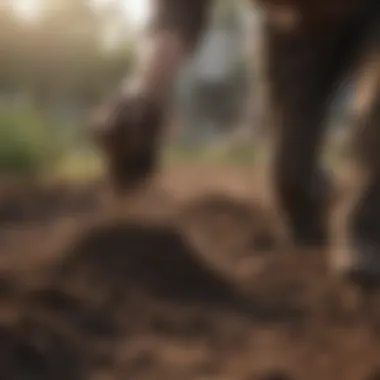Effective Strategies for Growing Grass in Bare Areas


Intro
Establishing grass in bare areas of a lawn can seem like a challenging task. However, with the right knowledge and preparation, it is entirely achievable. This guide aims to illuminate the essential techniques and factors that contribute to successful grass growth. Homeowners and gardening enthusiasts will find valuable insights that can transform neglected spaces into thriving green areas, enhancing both the beauty and function of their outdoor environments.
Understanding the complexities involved in grass establishment requires careful consideration. The selection of appropriate seed varieties, thorough site analysis, and effective maintenance strategies are just a few of the elements which play pivotal roles in this process. The intention is to equip readers with comprehensive tools and strategies that can result in verdant lawns and inviting landscapes.
Design Inspiration
After bare areas are prepared for grass, considering design inspiration can be beneficial in guiding future landscaping decisions. The design does not merely add to aesthetic appeal, it can also influence the overall health of the grass and its surroundings.
Trending Styles
In recent years, sustainable landscaping and native plant integration have gained traction. These trends prioritize biodiversity and environmental health. Incorporating native grasses can contribute significantly to soil health and attract local wildlife, such as birds and butterflies. Homeowners should explore various grass types suitable for their local climate, ensuring that the chosen varieties not only serve a functional purpose but also look harmonious in their respective environments.
Color Palettes
When contemplating color palettes for lawns, various shades of green can be integrated, enhancing visual interest. Mixing different grass types can lead to a more dynamic look. Consider darker greens for contrast and lighter hues for a softer touch. It is essential to take into account seasonal color changes, as some grasses may exhibit a vibrant look in summer while fading in winter.
Practical Tips
Equipping yourself with practical tips is crucial for effectively managing newly established grass areas. Achieving and maintaining a healthy lawn involves several steps that require ongoing attention.
Maintenance & Care
Regular maintenance not only fortifies grass but also contributes to overall lawn health. Initially, watering the grass appropriately is key. Newly sown seed needs consistent moisture for growth. Implement a watering schedule, aiming for about one inch of water per week.
Fertilization should also be considered. Utilize a slow-release fertilizer after germination to support growth. Timing is vital; early spring or early fall may be optimal for growth, depending on your grass type.
Moreover, keep watch for pests and disease. Early detection and intervention are crucial for maintaining a lush lawn. Monitoring can be aided through visual inspections and soil testing, helping to determine nutrient needs and any pest issues.
Budgeting & Planning
Planning a budget for grass establishment can help manage expectations. Costs can vary based on several factors like seed quality, soil improvements, and maintenance tools. Allocating funds for organic fertilizers and pest control products may initially seem high but can prove to be cost-effective in maintaining a healthy lawn long term.
Creating a timeline is also essential in planning. Spring or early fall are generally the best times for sowing grass seed. Therefore, setting goals for each season will help in tracking progress and ensuring timely maintenance tasks.
Proper site preparation and attentive care create the foundation for a thriving lawn.
Finale
In summary, growing grass in bare areas requires thorough planning and understanding of various elements involved in the process. Whether it's choosing the right seeds, prepping the soil or implementing effective maintenance, these factors collectively contribute to the successful establishment of lush green spaces. The information shared here serves as a fundamental guide for anyone looking to elevate their outdoor areas, resulting in not only increased aesthetic value but also contributing positively to the environment.
Prologue to Grass Growth
Grass serves as a foundational element in many landscapes and lawns. Its presence contributes significantly to the overall aesthetic appeal of a property. Understanding how to successfully nurture grass in bare areas is crucial for home and garden owners. Not only does grass enhance visual beauty, but it also promotes environmental benefits like soil stabilization, habitat creation for various organisms, and improved air quality.
When approaching grass growth, several key elements warrant attention. Site analysis is indeed a vital first step. This involves assessing geographical factors, such as sunlight exposure and soil quality. These attributes directly impact the grass's capacity to thrive. Additionally, understanding the particular grass type suited for a specific environment is equally important. Each species has unique requirements and tolerance levels.
Another important consideration is the long-term commitment required to maintain lush green spaces. Grass does not simply grow without care. Homeowners have to establish watering schedules, fertilization practices, and pruning techniques. The health and longevity of grass depend on these continuous efforts.
In summary, delving into the nuances of grass growth goes beyond surface-level actions. Recognizing the importance of grass and addressing the factors that contribute to its growth can transform barren areas into vibrant greenery. This understanding enables homeowners to enjoy the many advantages that a healthy lawn brings.
Understanding the Importance of Grass
The role of grass in the ecosystem can’t be overstated. It provides a habitat for numerous insects, birds, and small mammals. Additionally, when it comes to temperature regulation, grasses play an important role by absorbing sunlight and releasing moisture into the atmosphere. Thus, adding grass to bare areas not only beautifies the landscape but also enhances the local environment.
Lawns offer practical benefits, too, such as minimizing erosion and reducing water runoff. Areas covered in grass help to filter water, improving its quality before it enters waterways. Furthermore, maintaining healthy grass can result in significant cost savings. With proper care, homeowners may reduce the need for chemical herbicides and pesticides, contributing to sustainable gardening practices.
Common Reasons for Bare Areas
Bare areas can appear in any lawn for several reasons. One common cause is poor soil quality. If soil lacks essential nutrients, grasses may struggle to establish roots. Additionally, areas that experience excessive foot traffic can lead to soil compaction, making it difficult for grass to take hold.
Another factor contributing to bare patches is environmental conditions. Variations in sunlight and moisture can result in uneven growth patterns. For example, shaded areas tend to inhibit grass growth, while overly wet regions may foster mold and disease.
Moreover, various pests or diseases can detract from lawn health, leaving spots devoid of grass. Identifying these problems is crucial. Homeowners should regularly monitor their lawns and respond to changes promptly.
Assessing the Site Conditions
When it comes to nurturing grass in bare areas, assessing site conditions is a fundamental step. It provides a clear understanding of the environment where grass will grow. By evaluating multiple aspects of the site, homeowners can create optimal conditions for grass development. This phase often determines how successful the grass establishment process can be.
Evaluating Sunlight Exposure
Sunlight exposure plays a crucial role in grass growth. Different types of grass require varying amounts of sunlight. For instance, some grasses thrive in full sun, needing six or more hours per day, while others may be adapted for shaded areas with less direct light. To evaluate sunlight exposure:
- Walk around the site at different times of the day. This will help identify where sunlight reaches the ground and where shadowy spots remain.
- Take note of any structures or trees causing shadows. This assessment can guide the choice of grass type later on.
- Keep in mind that insufficient sunlight can stunt growth, making it more susceptible to pests and diseases. Thus, understanding sunlight patterns is vital before proceeding.
Identifying Soil Type
Soil type significantly influences grass growth. Different soils have varied textures, drainage capabilities, and nutrient levels. To identify soil type, follow these steps:


- Conduct a soil test: Kits are available at garden centers. This will reveal pH levels and nutrient content.
- Examine soil texture: Grab a handful of moist soil and squeeze it. If it forms a ball, it’s likely clay. If it crumbles, it's sandy. Soil rich in organic matter displays a crumbly texture.
- Consider soil drainage: Perform a simple test by digging a hole, filling it with water, and timing how long it takes to drain. Well-drained soil is essential for healthy grass growth.
This knowledge enhances decision-making regarding amendments and the type of grass suitable for the area.
Examining Drainage and Water Availability
Adequate drainage and water availability are essential for grass health. Poor drainage can lead to water pooling, which suffocates grass roots and fosters disease. To assess drainage:
- Observe how water behaves during rainy weather. Do puddles form? Are there spots that seem marshy?
- If the area holds water for extended periods, it’s vital to enhance drainage before planting grass. This can include adding organic matter or better soil types that improve aeration and drainage.
- Water availability must also be considered. Examine if there is an irrigation system or hose access. New grass requires ample water, especially in its early stages.
Ensuring that the site has proper drainage and water sources will position the grass for survival and growth in the long term.
Preparing the Soil for Grass Growth
Preparing the soil is a critical step in growing grass, especially in bare areas. Without proper preparation, even the best grass seeds may struggle to establish themselves. It sets the foundation for healthy growth, ensures enough nutrients, and provides a good rooting environment.
Clearing Debris and Weeds
The first step in soil preparation is clearing the area of debris and weeds. This includes rocks, old roots, and any other materials that can obstruct grass growth. Weeds are particularly problematic as they compete for nutrients and water. Removing these unwanted plants can greatly improve the chances of grass seeds thriving. A garden rake or hoe is useful for this task. Ensure you dig deeply enough to remove roots completely. Disposing of the debris properly is also important; composting can be a good option if the materials are disease-free, as it can later be used to enrich the soil.
Testing Soil pH and Nutrients
Soil testing is a crucial step in understanding the existing conditions. It assesses pH levels, which dictate how well grass can absorb nutrients. Most grasses prefer a pH range of 6.0 to 7.0. Testing kits are readily available at garden centers or online. The results will often indicate if your soil is too acidic or alkaline and if it lacks essential nutrients, such as nitrogen, phosphorus, or potassium. Performing a soil test before seeding can inform you about necessary amendments.
Amending Soil for Optimal Conditions
Once you understand your soil's composition and needs, amending it is next. This involves adding organic matter, like compost, to enhance nutrient levels and improve soil structure. If the soil is compacted, aeration can be helpful, allowing air, water, and nutrients to penetrate. Lime can be added to raise the pH, while sulfur can lower it if needed. Ensure the amendments are mixed evenly into the soil to create a balanced environment. This proactive approach strengthens the area significantly, leading to more robust grass growth.
Proper soil preparation increases the odds of successful grass growth significantly. It creates the conditions where seeds can sprout and flourish, turning bare areas into lush, green spaces.
By focusing on these key soil preparation steps, homeowners can provide their grass the best possible start. Each measure taken will lead to a healthier lawn, contributing to its beauty and overall environment.
Choosing the Right Grass Seed
Selecting the right grass seed is crucial for achieving a thriving lawn in bare areas. The grass type directly influences not only the visual appeal of your yard but also its resilience, maintenance requirements, and how well it adapts to the local climate. A well-chosen grass seed can lead to faster germination, increased drought resistance, and overall healthier growth, allowing your yard to flourish in any condition.
Types of Grass Seeds
Grass seeds come in two main categories: cool-season and warm-season grasses.
- Cool-season grasses such as Kentucky Bluegrass and Perennial Ryegrass thrive in northern climates and prefer cooler temperatures. They grow best during spring and fall.
- Warm-season grasses like Bermuda Grass and Zoysia Grass perform well in southern regions, becoming more active in the heat of summer.
Each type has its unique characteristics and advantages; hence, understanding your region's climate is essential in making the right selection.
Selecting Grass Based on Climate and Usage
When choosing grass seed, consider the local climate and intended use of the area. Generally, the type of grass affects how well it grows under specific conditions. Here are some points to ponder:
- Climate zone: Understanding whether you live in a cool or warm climate will guide you in selecting the species to opt for.
- Shade vs. Sun: Some grasses handle shade better than others. For example, Fine Fescue is suitable for shaded areas, while Tall Fescue is more drought-tolerant.
- Usage: Consider how the area will be used. A lawn experiencing heavy foot traffic needs a resilient variety like Kentucky Bluegrass, while a less-trafficked ornamental area can feature a more delicate grass type.
Understanding Seed Quality and Certification
The quality of grass seed is paramount for ensuring a successful lawn. Quality indicators include germination rates, purity rates, and the presence of weed seeds. Certified seeds, which meet specific standards set by agricultural bodies, generally provide better performance. Look for labels indicating:
- Germination percentage: This shows how many seeds are expected to sprout.
- Purity: This tells you the proportion of pure grass species in the package.
- Weed seed content: It’s important that your seed is free from competing weed seeds which can hinder the growth of your grass.
Seeding Techniques for Success
Seeding can be a critical aspect in achieving a healthy lawn. Proper techniques in this phase can influence both immediate germination and long-term growth. Understanding the nuances of seeding techniques allows homeowners to avoid common pitfalls. Following the right methods not only promotes faster establishment of grass but also leads to denser coverage. This means fewer bare spots in the future.
Seed Application Methods
When applying grass seed, uniformity is key. There are a few methods to ensure even distribution. Hand application can work for small areas, but it is less effective for larger spaces. For larger areas, it is advisable to use a seed spreader. This tool helps achieve an even distribution of seed. Different seed spreaders are available, like broadcast and drop spreaders. Broadcast spreaders distribute seeds widely, while drop spreaders allow for more precise application.
Additionally, it is better to apply seeds in two directions. This technique reduces gaps and overlaps. Following this method enhances the chances of successful germination across the entire area.
Timing for Seeding
Timing plays a significant role in grass establishment. The seasons greatly impact the success of grass growth. Most grass types thrive if seeded during their peak growing season. For cool-season grasses, the best period is early spring or early fall. Warm-season grasses, however, should ideally be seeded in late spring or early summer. Planting during these optimal times can lead to quicker germination.
Furthermore, checking local weather conditions is essential. Avoid seeding during periods of extreme heat or unpredictable weather. These factors can hinder grass growth and lead to waste.
Covering Seeds for Protection
Post-application, protecting the seeds is vital for their success. A thin layer of mulch can help shield seeds from birds and harsh weather. It also helps retain moisture in the soil, fostering ideal conditions for germination. Using straw, peat moss, or compost as a covering material is effective. These options decompose and can add nutrients to the soil, enhancing growth.
Keep in mind that while covering seeds is important, it should be a light layer. Too thick a covering can suffocate seeds and inhibit their ability to break through the soil.
Proper seeding techniques can greatly influence the success of your grass growth, making each step crucial for establishing a healthy lawn.
Implementing these techniques ensures the right conditions for grass to flourish. Methods of seed application, timing, and covering all play interconnected roles in achieving the lush green spaces you desire.


Watering Guidelines
Effective watering is essential for grass growth, particularly in bare areas where the soil may lack moisture and nutrients. A consistent watering approach can significanlt promote seed germination and encourage root development. Proper watering practices contribute not only to the health of the grass but also improve the overall appearance of the lawn. When grass receives adequate water, it successfully establishes itself and becomes resilient against diseases and pests. As part of this comprehensive guide, understanding watering guidelines will ensure your efforts in growing grass yield the best results.
Establishing a Watering Schedule
Creating a watering schedule is essential for new grass. New seeds require consistent moisture to germinate and grow. Generally, it is advisable to water lightly but often in the beginning. Aim to water the seeds about twice a day. Morning hours, specifically between 6 AM and 10 AM, are optimal due to lower heat and wind, which minimize evaporation. Later, once the grass is established, you can adjust the schedule to fewer days, allowing deeper watering to promote stronger roots.
Some things to consider when establishing a watering schedule include:
- Soil Type: Sandy soils drain faster and may require more frequent watering, while clay soils retain moisture longer.
- Weather Conditions: Hot and dry days will necessitate more watering, whereas cooler and rainy days might decrease the need.
- Grass Type: Different grass species have varying water requirements; for instance, Kentucky bluegrass needs more water than fescue grass.
Watering Techniques for New Grass
When it comes to watering new grass, technique is a critical factor. Here are some techniques that can help enhance the effectiveness of your watering:
- Sprinkler System: A well-distributed sprinkler system ensures even coverage. Stationary sprinklers should be moved around to avoid dry patches.
- Soaker Hoses: These can be laid out directly on soil to deliver moisture right where it is needed, reducing evaporation loss.
- Hand Watering: Using a hose with a nozzle can also be effective for small areas, allowing for precision watering.
- Monitoring Moisture: Always check the soil to evaluate moisture levels. If the top inch of the soil feels dry, it is time to water again.
Identifying Signs of Over or Under-Watering
Recognizing the signs of over or under-watering is crucial in maintaining healthy grass. Some common indicators include:
- Signs of Over-Watering: Golden or yellowing grass, soft or mushy patches, and a spongy feel underfoot can reveal excess moisture. In extreme cases, over-watering fosters fungal diseases.
- Signs of Under-Watering: Wilting grass, brown patches, and a crunchy texture when walking on the lawn display the need for water. Grass might also fall flat instead of standing upright.
Monitoring your watering habits can prevent serious damage to your grass and help maintain a thriving lawn.
By following these watering guidelines, the chances of successfully growing grass in bare areas increase significantly. Regular attention and adjustment of watering habits will lead to robust grass development.
Fertilization Practices
Fertilization is a crucial component in establishing and maintaining healthy grass. Proper fertilizer application provides the necessary nutrients that grass requires to grow strong and resilient. Without adequate fertilization, grass may struggle to thrive, leading to patches that remain thin or barren. Thus, understanding how to effectively use fertilizers is essential for anyone looking to enhance their lawn.
Choosing the Right Fertilizer
When selecting a fertilizer, it is important to consider its nutrient composition. Grass primarily needs nitrogen, phosphorus, and potassium for optimal growth. The N-P-K ratio on fertilizer bags indicates the percentage of these nutrients. For example, a fertilizer labeled as 10-10-10 contains equal parts of nitrogen, phosphorus, and potassium.
Additionally, the grass type you have may dictate the fertilizer choice. Cool-season grasses typically benefit from nitrogen-heavy formulas in early spring and fall, while warm-season grasses often require different nutrients. Research specific needs for your grass variety to ensure effective growth.
Timing and Frequency of Applications
The timing of fertilizer applications is just as critical as the choice of fertilizer. Typically, grass should be fertilized in the growing season. For cool-season grasses, this is in spring and fall. Conversely, warm-season grasses thrive under fertilization in late spring to summer.
Frequency is another consideration. Most lawns benefit from fertilization every 6 to 8 weeks during the growing period. However, over-fertilizing can lead to nutrient runoff and damage to the grass. Observing the health of your grass will also inform you whether adjustments are needed. If the grass appears excessively dark green or starts to burn, reduce the frequency.
Organic vs. Synthetic Fertilizers
The debate between organic and synthetic fertilizers continues among gardeners. Organic fertilizers are derived from natural sources such as compost, manure, or bone meal. They improve soil health over time, but they may release nutrients more slowly and can require more frequent applications.
In contrast, synthetic fertilizers often have quickly available nutrients that can provide immediate results. However, they carry a risk of nutrient leaching and can harm beneficial soil organisms if misused. Consider the long-term impact on your soil health when deciding between these options.
"The best fertilization practice aligns with both the immediate needs of the grass and long-term soil health."
Ultimately, understanding and implementing effective fertilization practices maximizes the potential for lush, vibrant grass. It is essential to consider your specific lawn conditions and preferences when navigating through the options available.
Mowing Practices Post-Growth
Mowing practices are an essential part of maintaining a healthy lawn, particularly following the growth of new grass. Proper mowing techniques contribute to the overall health of the grass, influence its resilience to pests and diseases, and enhance its aesthetic appeal. When managing your lawn, there are specific practices that should be adopted to ensure that the grass thrives.
Understanding Mowing Height
Mowing height is critical for grass health. Each grass type has a preferred mowing height, which should be adhered to for optimal growth. Cutting grass too short can expose the crown to stress, making it susceptible to weed invasion, and reducing its ability to photosynthesize.
A good rule of thumb is to follow the one-third rule: never cut more than one-third of the grass height at a time. For example, if your grass grows to 3 inches, set your mower to a height of about 2 inches during cutting. This practice encourages deeper root growth and enhances drought resistance.
Additionally, different grass varieties have their own specific height requirements. Kentucky bluegrass prefers 2.5 to 3.5 inches, while Bermudagrass often does well around 1 to 2 inches. It's essential to know your grass type to maintain appropriate heights, promoting a lush and vibrant lawn.
Mowing Frequency for New Grass
When it comes to new grass, mowing frequency should be adjusted based on growth rates and environmental conditions. Newly seeded grass should not be cut until it reaches a height of at least 3 inches. This helps establish strong roots and promotes healthy growth.
A common recommendation is to mow every 7 to 14 days, depending on varying factors like rainfall and sunlight. Regular mowing encourages thicker grass as it stimulates lateral growth, aiding in the development of a denser lawn that can naturally choke out weeds. It’s crucial to observe the growth rate and adjust accordingly; if the grass is growing rapidly, more frequent mowing might be necessary.
Ensure that your mower blades are sharp. Dull blades can tear grass rather than cutting it cleanly, leading to brown edges and an unhealthy appearance. Clean cuts also reduce the risk of disease by minimizing the damage to the grass.
Tip: Pay attention to your lawn's conditions. Soil moisture, weather patterns, and the specific grass type all influence when and how often to mow.
In summary, effective mowing practices post-growth are vital for nurturing new grass. Understanding appropriate mowing heights and adjusting frequency according to growth will create a healthy, resilient lawn that can thrive in any environment.
Weed Control Methods
Weed control is a vital aspect of maintaining a healthy and robust lawn. Weeds can compete with grass for essential resources, such as sunlight, water, and nutrients, ultimately affecting the growth and appearance of your grass. In bare areas, where grass is vulnerable, weeds can take over quickly. Understanding the types of weeds that might sprout and how to manage them is crucial for establishing a flourishing lawn.


Identifying Common Lawn Weeds
Awareness of the common weeds in your area is the first step in effective weed management. Some prevalent weeds include:
- Dandelion: Known for its bright yellow flower and fluffy seed heads, dandelions thrive in disturbed soils. They have deep taproots, making them challenging to remove.
- Crabgrass: This annual weed spreads quickly, especially in warm weather. It has a distinct sprawling habit and can significantly outcompete new grass.
- Clovers: Often seen as a nuisance, clovers tend to flourish in sunny areas and can create patches that can inhibit grass growth.
Identifying these weeds early allows for swifter action, which is essential in preventing them from taking hold in your new grass areas.
Preventive Measures for Weeds
Prevention is more effective than dealing with weeds after they’ve emerged. Some practical preventive measures include:
- Proper Lawn Care: Maintaining a healthy lawn through regular mowing, proper fertilization, and adequate watering creates an environment where grass can thrive, reducing the chances of weed establishment.
- Seeding Thickly: When sowing grass seed, aim for a thick coverage. Denser grass can outcompete weeds for resources.
- Mulching: For bare spots, applying a thin layer of mulch can help suppress weed growth until grass establishes.
Implementing these strategies will help to create an environment less conducive to weed proliferation.
Post-Emergence Weed Control
Despite best efforts, weeds may still appear after grass has been seeded. Effective control methods are necessary to maintain grass health:
- Hand Pulling: For small infestations, removing weeds by hand is a practical and environmentally friendly solution. Ensure to remove the whole root to prevent regrowth.
- Herbicides: When using herbicides, opt for products that target specific weeds without harming your grass. Be cautious with timings, as applying these on newly seeded areas can damage young grass.
- Spot Treatments: If a few weeds emerge, apply treatment only to those areas, rather than broadcasting chemicals across the entire lawn.
Managing weeds effectively contributes significantly to the conditions needed for grass to thrive. Ensuring that weeds do not establish themselves in bare areas is fundamental in achieving the lush, verdant lawn desired.
By understanding how to identify, prevent, and control weed issues, homeowners can ensure their grass has the best chance of flourishing in previously bare areas.
Maintenance Strategies for Long-Term Health
Maintaining the health of grass after it has been established is essential for keeping it lush, green, and resilient over time. Proper maintenance strategies play a pivotal role in the longevity and vibrancy of your lawn. These methods not only ensure that the grass stays healthy but also help to prevent issues such as weeds, pests, and diseases from taking hold. A well-maintained lawn enhances aesthetic appeal while providing ecological benefits, such as soil erosion control and improved air quality. It is paramount to adopt a proactive approach to care for your grass.
Regular Soil Testing
Regular soil testing is an integral part of maintaining the health of your grass. This process involves analyzing the soil composition to determine nutrient levels, pH balance, and organic matter content. Testing can be conducted through local agricultural extensions or home testing kits. The information gained from these tests drives future fertilization decisions and amendments. Based on the results, homeowners can take targeted actions, such as applying fertilizers or lime to correct pH levels.
- Benefits of Soil Testing:
- Identifies nutrient deficiencies that can hinder grass growth.
- Helps in creating a customized fertilization plan.
- Prevents over-fertilization, reducing environmental runoff.
By understanding the soil's condition, homeowners can provide their grass with the exact nutrients it requires, promoting strong root systems and vibrant growth.
Seasonal Care Practices
Seasonal care practices encompass a variety of activities that align with the changing needs of grass throughout the year. Each season brings specific requirements which can greatly influence the health of the grass.
- Spring: This is when growth begins to pick up. Activities such as aerating the soil, applying fertilizers, and overseeding are often recommended. Aeration allows air, water, and nutrients to penetrate the grass roots.
- Summer: Watering becomes crucial during this time. Grass may require deeper watering sessions to promote stronger roots. Avoid mowing grass too short, as this stresses the plants.
- Fall: This is a critical season for preparation. Fertilizers are often applied to build up reserves for the winter months. It is also a good time for overseeding or patching bare spots as temperatures cool down.
- Winter: While little is needed in terms of maintenance, protection against heavy foot traffic can help prevent soil compaction.
Each seasonal activity contributes to a comprehensive maintenance plan. By adhering to these seasonal care practices, grass can thrive and maintain its health for many years ahead.
Addressing Challenges in Grass Growth
When trying to establish grass in bare areas, homeowners face several challenges that can hinder growth. Understanding these challenges is crucial for anyone looking to create a lush lawn. Each issue must be identified and approached strategically. Effective management ensures not only a healthy lawn but also a sustainable environment that can add value to properties.
Improper lawn care can lead to a variety of problems that negatively affect the growth and health of grass. These issues might stem from environmental factors, soil quality, or human intervention. Addressing these challenges involves diagnosing specific growth hurdles and implementing targeted solutions.
Diagnosing Growth Issues
To effectively address growth issues, one must first recognize the signs of trouble. Common diagnostics include:
- Patchy Grass Growth: This can result from insufficient water, poor soil quality, or the presence of pests.
- Yellowing of Grass: Often indicative of nutrient deficiencies or over-watering, leading to root rot.
- Weed Proliferation: Excessive weeds can overshadow grass, stealing essential nutrients and sunlight.
- Uneven Growth: Differences in sunlight exposure or soil quality often lead to uneven patches.
An essential first step is to observe the bare areas closely. Look for these symptoms and analyze their potential causes. In some cases, a soil test may be necessary to identify pH and nutrient levels, which can guide the necessary amendments.
Solutions for Common Issues
Once issues are identified, solutions can be very specific. Here are possible remedies for common growth problems:
- Improving Soil Quality: Introduce organic matter, such as compost, to enrich the soil and improve nutrient retention.
- Proper Watering: Ensure that watering is neither excessive nor sparse. A consistent watering schedule should be implemented, particularly during dry spells.
- Weed Management: Regularly check for weeds and employ both manual removal and herbicides when necessary, ensuring that new grass can thrive.
- Choosing the Right Grass: Select grass types suitable for your local climate and the intended use. This choice can significantly impact growth success.
- Consulting with Experts: For persistent problems, seeking advice from local horticultural societies or gardening experts can provide further insight tailored to your specific environment.
By diagnosing issues accurately and taking appropriate action, homeowners can overcome many common obstacles in grass growth. Ultimately, this leads to a healthier lawn that enhances curb appeal and environmental benefits.
Closure
Understanding how to successfully grow grass in bare areas is vital for homeowners and gardening enthusiasts. Throughout this article, we have explored various techniques and considerations that contribute to the establishment and maintenance of a thriving lawn. The journey to a lush green space starts with assessing site conditions, such as sunlight exposure and soil type, which play a significant role in grass growth.
Recap of Best Practices
To recap, here are the best practices to ensure successful grass growth:
- Assess Your Site Conditions: Examine the amount of sunlight and soil drainage to determine the best grass type.
- Prepare the Soil: Clear debris, test for pH levels, and amend the soil as needed.
- Choose the Right Grass Seed: Select a type suited for your climate and intended use.
- Follow Seeding Techniques: Use appropriate methods for applying seeds, and consider timing for optimal results.
- Water Wisely: Establish a consistent watering schedule and recognize signs of under or over-watering.
- Apply Fertilization Mindfully: Understand the differences between organic and synthetic fertilizers and when to apply them.
- Manage Mowing Practices: Adjust mowing height and frequency based on the growth of new grass.
- Control Weeds Effectively: Identify, prevent, and manage weeds to support grass health.
- Prioritize Maintenance Strategies: Regular testing and seasonal care keep the lawn healthy.
- Address Any Challenges: Stay vigilant about diagnosing and correcting growth issues promptly.
Following these steps can nurture your grass and transform barren areas into vibrant green spaces.
Encouragement of Ongoing Learning
As with many aspects of gardening, continuous learning is crucial. Trends in lawn care and techniques evolve over time. Homeowners should engage with community forums or local gardening clubs to share experiences and gather information. Utilizing resources such as Wikipedia, Britannica, and platforms like Reddit provide ample opportunities for knowledge acquisition.
Experimenting with different strategies allows for personal growth in gardening skills. As seasons change, revisit your practices and adapt as necessary. Remember, the cultivation of grass is not just about aesthetics; it fosters ecological benefits and enhances the natural beauty of your space. By committing to learning and applying best practices, your lawn will thrive for years to come.















